Economic Report on Scottish Agriculture, 2016
Presents an overall picture of Scottish agriculture using data from the various agricultural surveys that RESAS manage.
5.2 Cattle
Chart 5.4 shows that the number of cattle in Scotland has been steadily falling since an historical peak of 2.7 million in 1974. Prior to that it had risen from a constant 1.2 million in the first three decades of the 20 th century. Over half of that increase had been lost by 2015.
Chart 5.4: Number of cattle in Scotland, 1883-2015
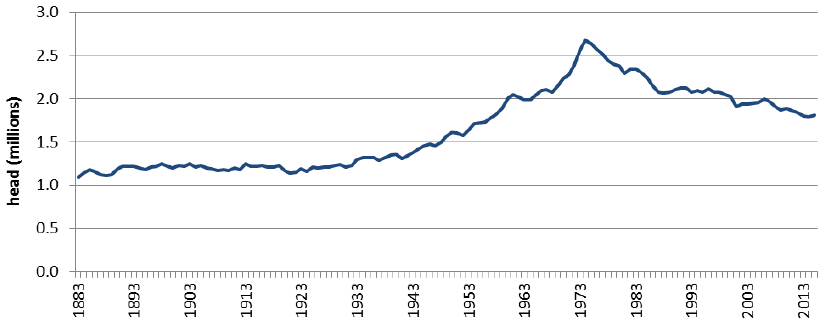
5.2.1 Distribution of dairy and beef herds ( Table C10(i), C10(ii))
In 2015 there were 1.81 million cattle in Scotland. The greatest number of cattle were located in Dumfries & Galloway (434,000 cattle or 24 per cent of the total) while 359,000 were in Grampian (20 per cent). Ayrshire (191,000 or 11 per cent), the Clyde Valley (140,000 or eight per cent), Scottish Borders (132,000 or seven per cent) and Highlands (126,000 or seven per cent) also had relatively high numbers of cattle.
Chart 5.5: Distribution of cattle by sub-region, June 2015
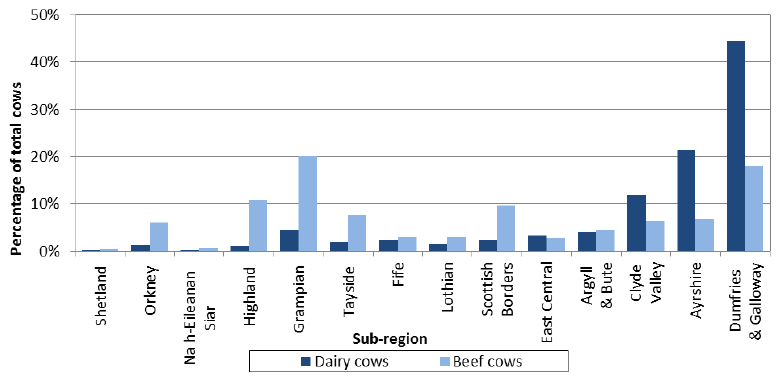
Dairy cows [9] totalled 176,000 in June 2015, of which just over three quarters were located across the south western sub-regions of Dumfries & Galloway (78,200 or 44 per cent), Ayrshire (37,600 or 21 per cent) and the Clyde Valley (20,900 or 12 per cent). In contrast, beef cows [10] , which totalled 437,000, had a wider regional spread, with large numbers evident in more northerly sub-regions such as Grampian (88,000 or 20 per cent) and Highland (47,600 or 11 per cent) as well as Dumfries & Galloway (79,100 or 18 per cent) and the Scottish Borders (42,200 or ten per cent). Map 10 illustrates that the highest density of cattle are to be found in the south-west and north-east. In addition, the inset map shows that beef predominates over dairy in most areas apart from patches in the south west of Scotland.
Map 10: Cattle per hectare in parish, 2015
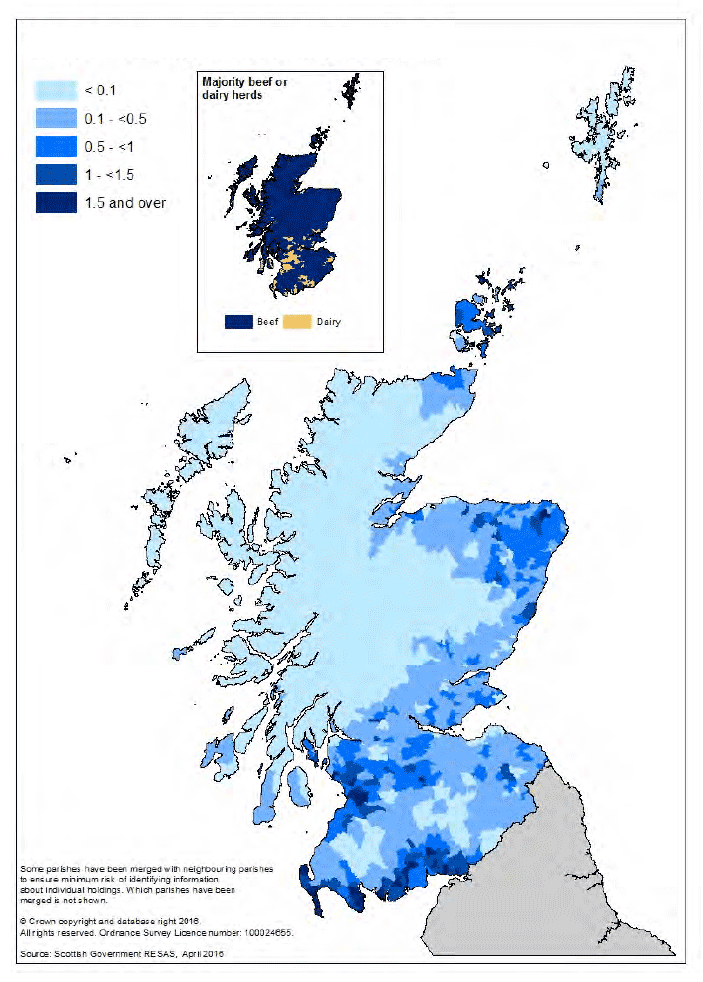
5.2.2 Size of beef and dairy herds ( Tables C11, C12)
Charts 5.6 and 5.7 illustrate the different distributions of beef and dairy cattle numbers. While 30 per cent of beef cows (131,000 cows) were in a herd size of 150 or more, 69 per cent of dairy cows (121,000 cows) were held in holdings with herds of 150 cattle and over. This illustrates the concentrated distribution of the dairy sector.
Chart 5.6: Beef cows by region and herd-size group, June 2015
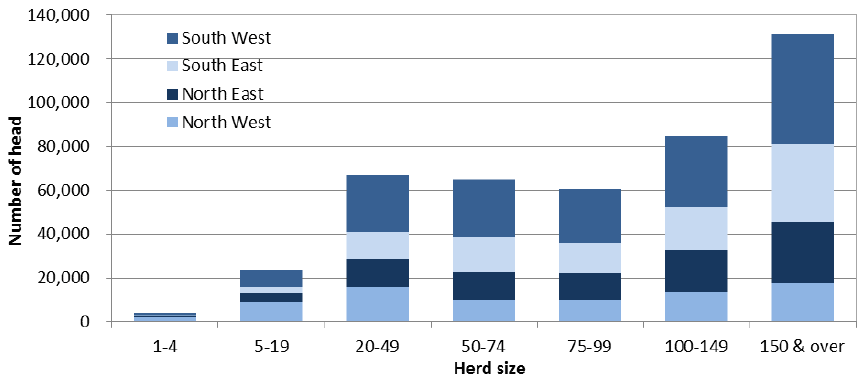
Chart 5.7: Dairy cows by region and herd-size group, June 2015
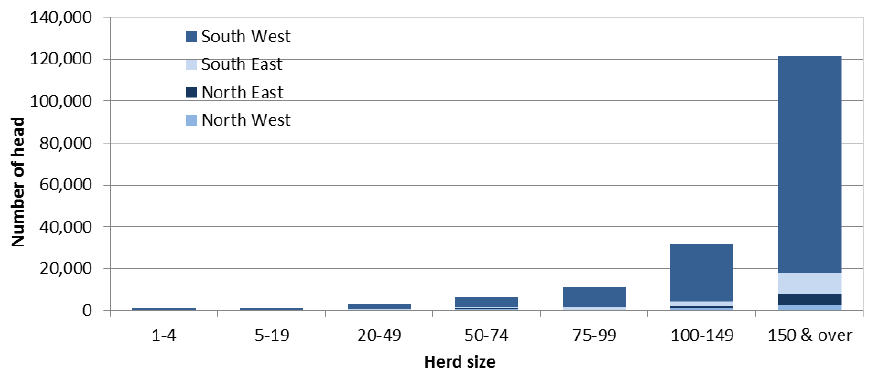
Data collected by the Scottish Dairy Cattle Association suggest that there were 982 milk-producing dairy herds in Scotland in July 2015, with a total of 174,487 cows, though the definition of which animals are included in that figure would differ from those used elsewhere in this publication.
5.2.3 Income from cattle ( Table A5)
Over the past decade the total output value of finished and store livestock, excluding related subsidies, has increased by £284 million (73 per cent) to £672 million in 2015 (chart 5.1). The value increased each year between 2005 and 2013 (except 2007) but has fallen slightly in the past two years. Two of the largest increases occurred in 2008 (£88 million) and 2011 (£81 million). Output from cattle equates to about 25 per cent of total agricultural output.
Tables A5 and A6 provide the detail behind these livestock valuations including numbers of livestock, weight of meat production, average output prices and stock change valuations.
In 2015, the output value of store cattle and calves was £51.4 million, up £2.5 million from 2014 (five per cent).
Total beef production in 2015 (including cull of older cattle) was at 169,000 tonnes, remaining fairly stable over the past ten years, with some higher levels in the intervening years (chart 5.2). Chart 5.8 shows that finished beef production was pretty much unchanged in 2015.
Chart 5.8: Finished cattle production and average price, 2005-2015
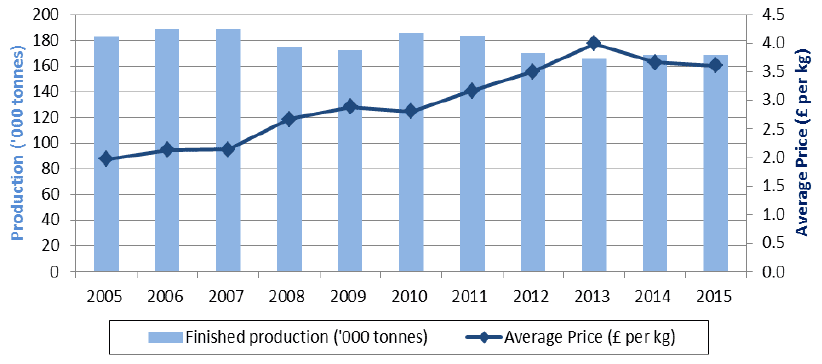
Clean finished cattle prices had risen in each year throughout the past ten years, except 2010, up from an average of £1.97 per kg in 2005 to £4.00 per kg in 2013, a rise of 102 per cent. This trend has been the key factor in the large increase in the output value of cattle. However there was an eight per cent fall in price in 2014 and a further two per cent decrease in 2015, to £3.61 per kg.
Chart 5.9 Monthly cattle marts prices in 2009, 2014 and 2015
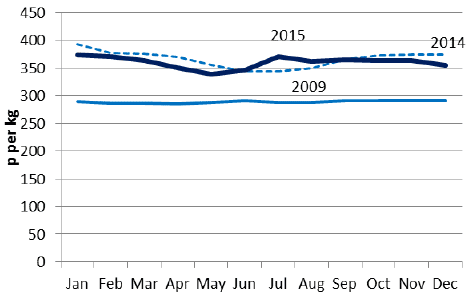
Prices started 2015 well, following on from the rises seen in the latter part of 2014, at around 374p per kg in January. Prices dipped during the first half of the year, rose in July, but fell back again, ending at 355p per kg.
5.2.4 Specialist Cattle ( LFA) FBI ( Table B1)
Accounting for inflation, between 2009-10 and 2014-15 the average FBI of specialist cattle ( LFA) farms decreased by around 49 per cent, to the second lowest level over the series. This decrease was due to a rise in spending on inputs, and a fall in livestock revenue. In the last year spending on inputs as well as revenue for specialist cattle ( LFA) farms have both decreased, along with a fall in subsidy value, resulting in an overall decline in profits for 2014-15. The FBI value of specialist cattle ( LFA) farms was £26,000.
The average FBI/ FTE for cattle farms of £18,000 is roughly equivalent to an hourly wage for unpaid labour of £9.39, around a third more than the minimum agricultural wage in Scotland. Around 44 per cent of specialist cattle ( LFA) farms generated incomes equivalent to less than the minimum agricultural wage ( MAW) whereas nine per cent generated more than five times MAW.
At an average of £63,000, on average, high performing specialist cattle ( LFA) farms generated incomes around two and a half times the overall average. Low performing farm businesses made an average loss of £10,000.
The total average revenue for specialist cattle ( LFA) farms, including income from diversification and subsidy payments, was £171,000. Spending on inputs averaged at £145,000. The largest portion of the input costs was due to feed and "other inputs" such as machinery and land and buildings.
Losses were recorded in each of the last six years when excluding subsidy payments. The losses ranged from £10,000 in 2009-10 to their highest level of £30,000 in 2013-14. In 2014-15 losses of £22,000 were recorded.
In the last year, cost centres for specialist cattle ( LFA) farms show an increase in income from agricultural activities and a decrease in direct payments. There has been little change to income from other cost centres.
The average net worth (assets minus liabilities) of specialist cattle ( LFA) farms was £1 million in 2014-15. The average debt ratio (liabilities:assets) remained unchanged at ten per cent for specialist cattle ( LFA) farms, but ranged between nine per cent for owner-occupied and 19 per cent for tenanted farms.
Specialist Cattle Farms ( LFA)
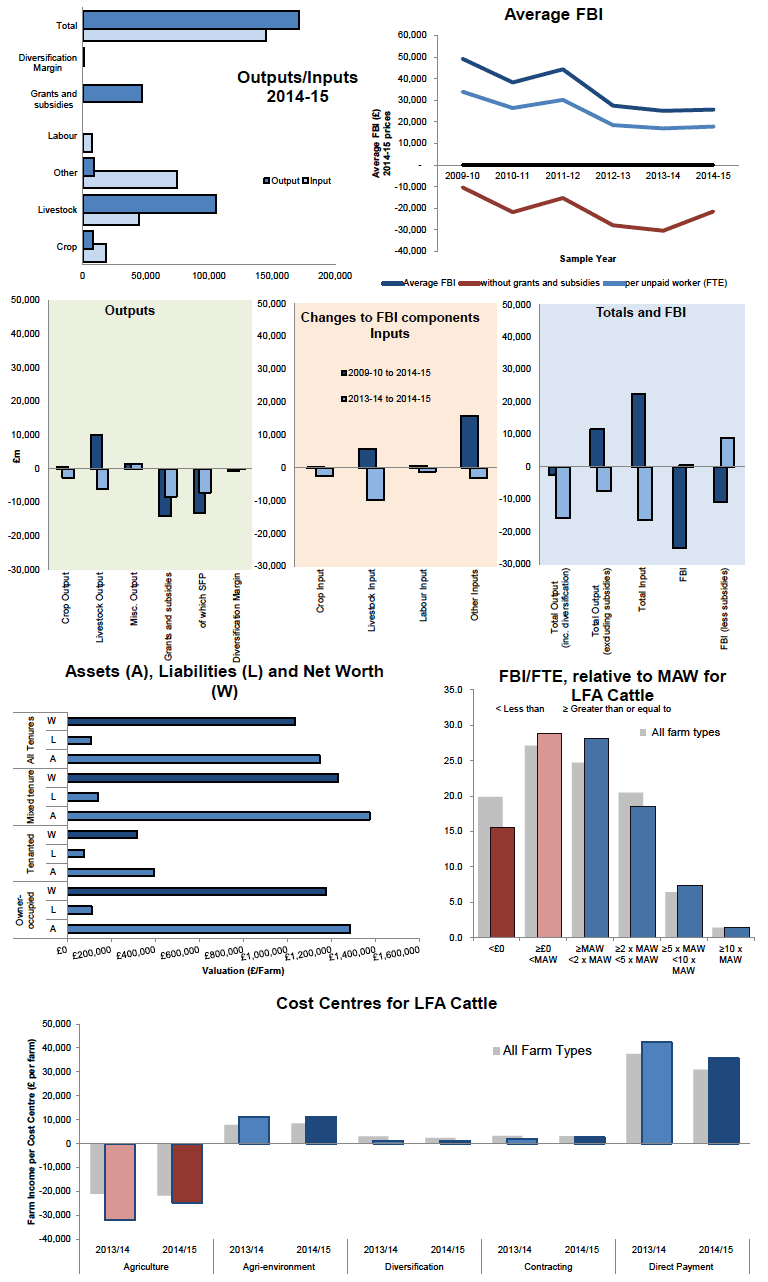
5.2.5 Income from milk and milk products ( Table A6)
The production of milk and milk products accounted for an estimated £364 million of output in 2015, about 12 per cent of total farming output. The value of milk was equivalent to over half the output from beef, and more than the value of meat from sheep, pigs and poultry put together. The value has increased by 49 per cent since 2005, with the most notable increases occurring in 2008 (25 per cent) and 2013 (16 per cent), but is showing a 20 per cent decrease in 2015 (see chart 5.12).
Milk production has been fairly steady in the last ten years, with very little difference between 2013 production and the 2005 level, followed by increases observed in the next two years. At an estimated 1.5 billion litres, production is now at its highest ever level.
Chart 5.10 Milk (including milk products) production and average price 2005 to 2015
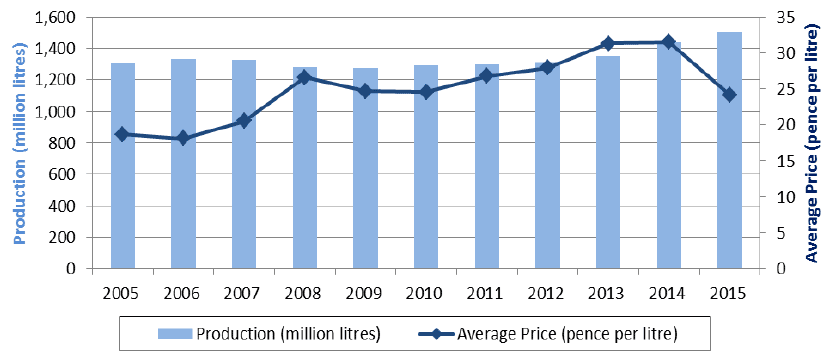
Chart 5.11 Monthly milk prices in 2009, 2014 and 2015
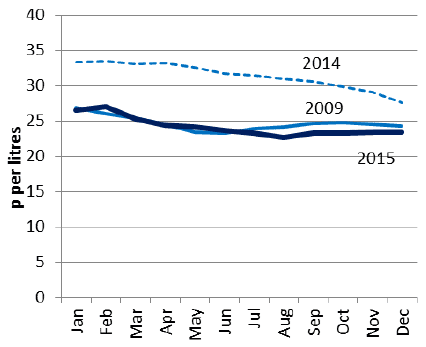
Chart 5.12 Output value of milk and milk products, 2005 to 2015
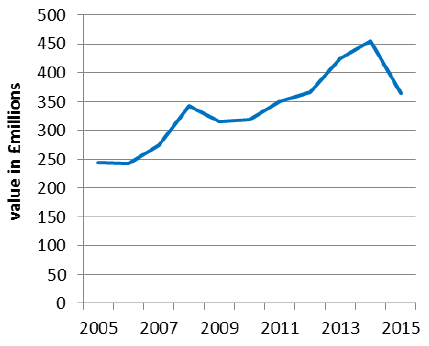
The average price of milk was 26.5p per litre in January 2015, down 21 per cent on January 2014. The monthly average price peaked at 27.1p per litre in February 2015, following which the price fell steadily, ending the year at 23.4p per litre.
In 2015 much of the milk processed in Scotland was used directly as liquid milk for human consumption, with more semi-skimmed and skimmed than whole or standardised milk. Cheese production was the next largest use. Other uses included chocolate crumb, butter, cream, ice cream and yoghurt.
5.2.6 Specialist dairy FBI ( Table B1, B4)
Accounting for inflation, between 2009-10 and 2014-15, the average FBI of dairy farms decreased by around 22 per cent. Incomes for dairy farms fell considerably in 2012-13 from £86,000 to the lowest level over the series at £47,000. Incomes partially recovered to £79,000 in 2013-14, before falling once more in 2014-15. The latest decrease in income was due to an increase in the input costs for livestock, machinery, land and buildings.
In 2014-15, revenue for dairy farms decreased along with a decrease in the value of subsidy payments, resulting in an overall decrease in income. In 2014-15 the FBI value of dairy farms was £68,000, the highest of any farm type in the survey.
The average FBI/ FTE for dairy farms of £34,000 is roughly equivalent to an hourly wage for unpaid labour of £17.84, almost equivalent to two and a half times the minimum agricultural wage in Scotland. Around 30 per cent of dairy farms generated incomes equivalent to less than the minimum agricultural wage ( MAW), whereas 15 per cent generated more than five times MAW.
At £161,000, on average, high performing dairy farms generated incomes around two and a half times the overall average. Low performing farm businesses broke even, on average.
The total average revenue for dairy farms, including income from diversification and subsidy payments, was £489,000. Spending on inputs averaged at £420,000. The largest portion of the input costs was due to livestock costs such as feed and other inputs such as machinery and land and buildings.
Over each of the last six years, FBI without subsidy payments has still recorded a profit. It ranges from £4,000 in 2012-13 to the highest figure of £42,000 in 2011-12. In 2014-15, the average FBI without subsidies of dairy farms was £32,000.
Over the last year cost centres for dairy farms show little change in income from agricultural activities. Direct payments have decreased and there has been a small decrease in income from diversification, while other cost centres have seen little change.
The average net worth (assets minus liabilities) of dairy farms was £1.8 million in 2014-15. The average debt ratio (liabilities:assets) remained unchanged at 13 per cent. Analysis by tenure type is not available for dairy farms due to small sample sizes.
Dairy Farms
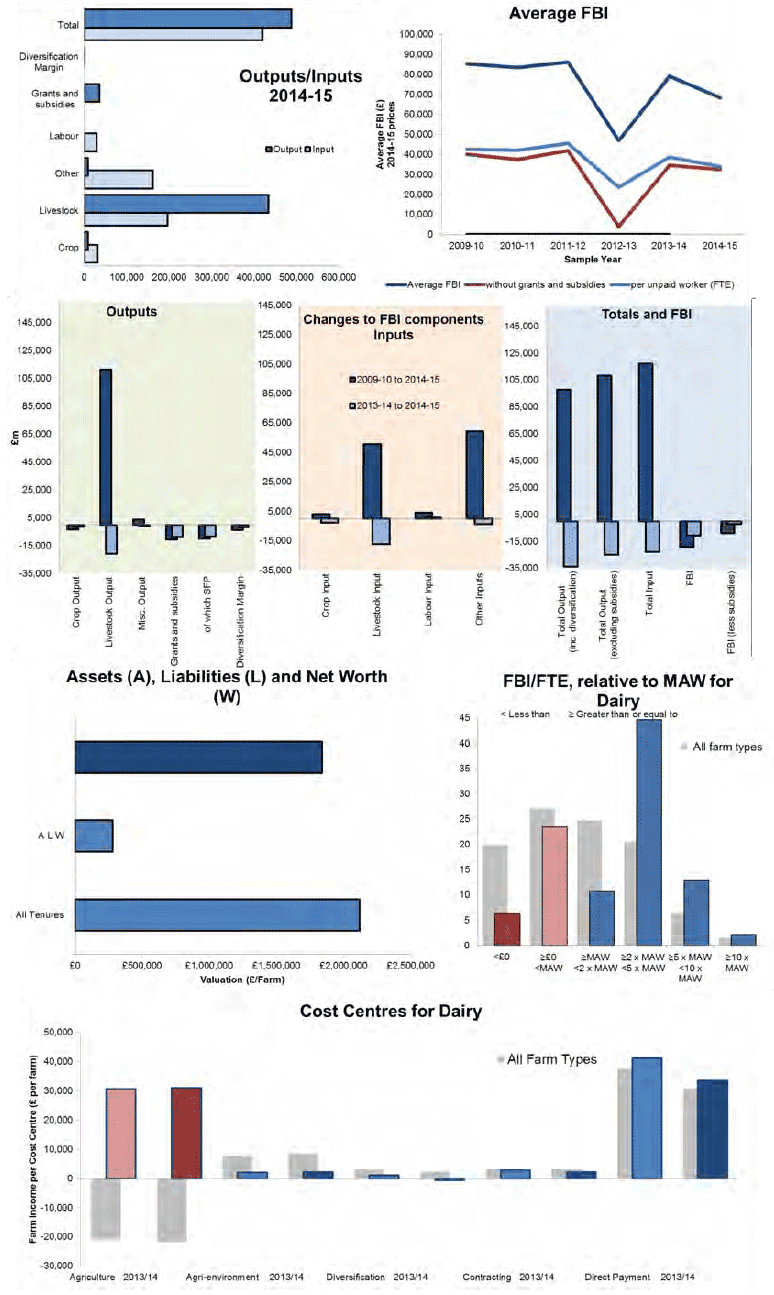
5.2.7 Dairy and beef enterprises ( Table B12)
Overall average gross margins for dairy and beef enterprises ranged from £44 per head for forward store enterprises to £375 per head for upland suckler store enterprises, with the exception of dairy cow enterprises at £1,118 per head (equivalent to 15.2 pence per litre).
Where sample sizes were sufficient to allow comparisons between high and low performers, we can see that low performing dairy and beef enterprises generated considerably lower margins. Some low performing dairy and beef enterprises generated losses, with dairy followers, lowland sucklers and finishing enterprises making an average loss, with gross margins ranging from ‑£50 per head for finishing enterprises to ‑£112 per head for dairy followers. By comparison, high performers in these enterprises achieved gross margins between £406 per head and £822 per head.
High performing dairy cow enterprises made around twice the average gross margin compared to low performers, at £1,588 per head. At £497 per head, high performing dairy mixed and dairy beef made around eight times the margin of low performing enterprises.
In dairy and beef enterprises the difference in financial performance was due to high performers achieving; higher sales prices per head (which is expected to reflect generally higher quality outputs), a greater increase in value due to improved technical performance, and better management of variable costs.
All dairy and beef enterprise groups, with the exceptions of upland suckler stores, hill herds and dairy followers, saw reduced margins compared to the previous year. Enterprise margins for upland sucklers, hill herds and dairy followers increased by 32, 48 and 11 per cent respectively. Forward store enterprises experienced the largest decrease in income, with the average margin 68 per cent lower than in 2013‑14. The lower margins are largely the result of the lower output value of dairy and beef cattle in 2014-15, reflecting lower prices, despite most enterprise groups reducing their spend on variable costs. Lower milk prices have also impacted on gross margins for dairy enterprises.
Taking account of the size of enterprises, dairy cow (£198,000), mixed dairy and dairy beef (£41,000) and upland suckler store (£33,000) enterprises achieved the highest overall enterprise income. Beef forward stores (£3,000) and beef hill herds (£13,000) achieved the lowest. The group average output:input ratios, the return achieved per £1 spent, ranged from 1.2 for forward stores, to 2.1 for dairy cow enterprises.
More detailed results, including sample size information, are available from the agriculture statistics web page, Enterprise Performance Analysis [11] .
Dairy and Beef: Enterprise Gross Margin Measures
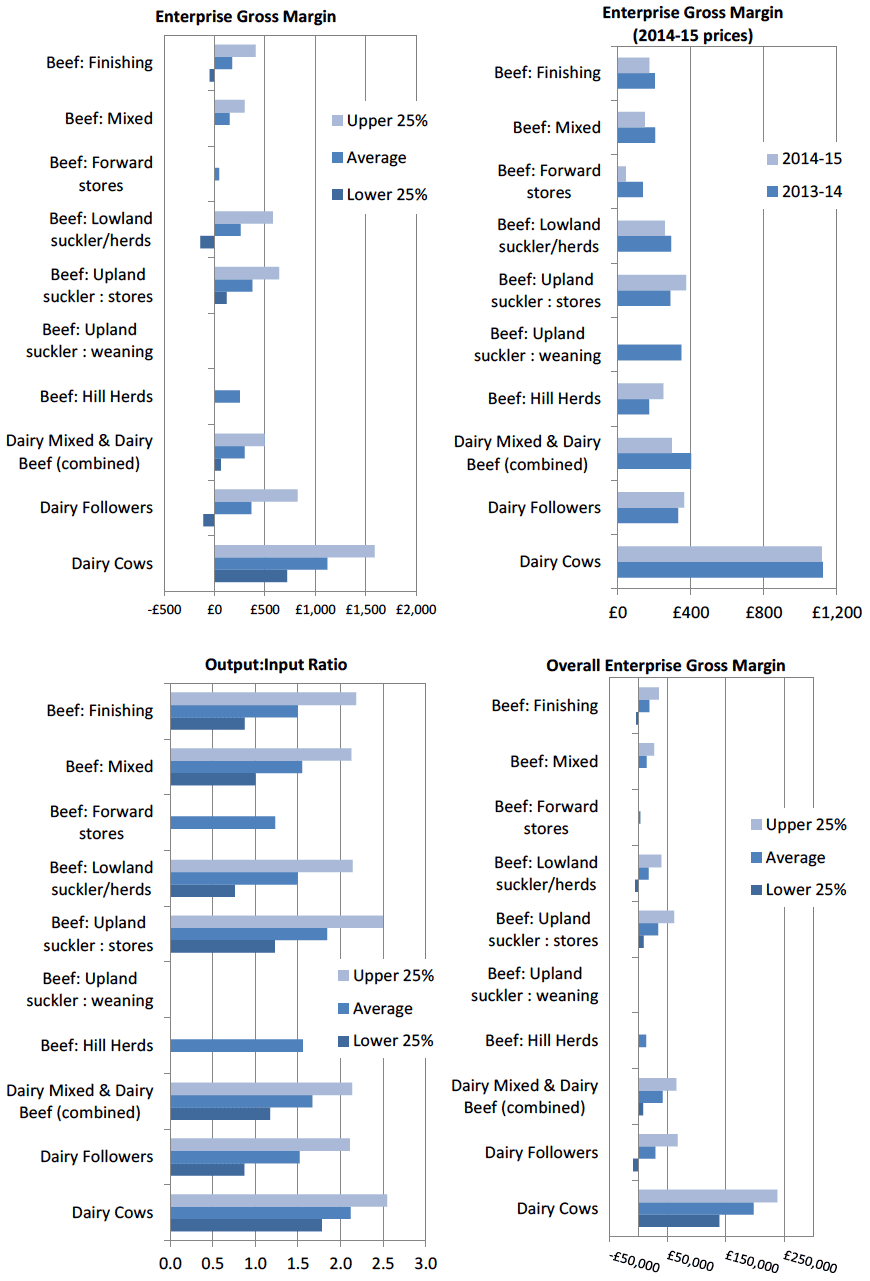
Contact
There is a problem
Thanks for your feedback